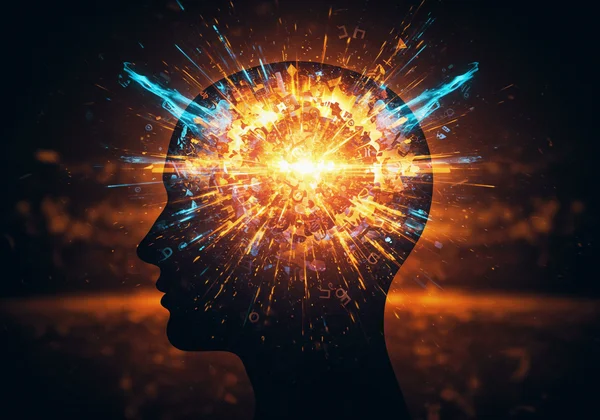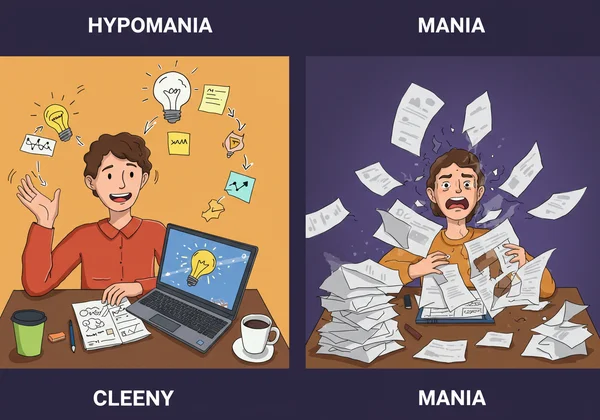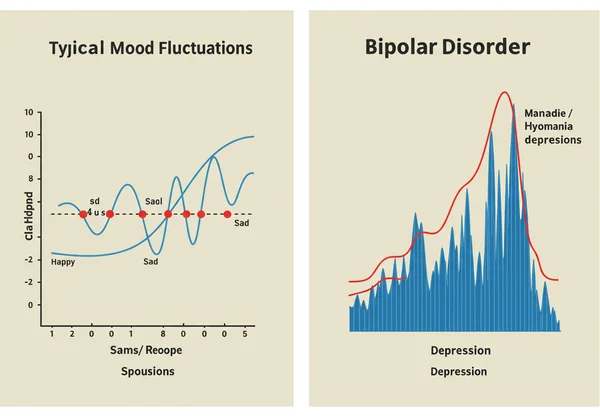What a Manic Episode Feels Like & How a Bipolar Test Can Help
Feeling on top of the world, yet uncontrollably fast? It can be a confusing and overwhelming experience. You might be filled with brilliant ideas, boundless energy, and an unshakeable belief that you can achieve anything. But at the same time, your friends and family may seem worried, unable to keep up with your racing thoughts and rapid-fire speech. If this sounds familiar, you're likely asking yourself, what does a manic episode feel like?
This guide is here to help demystify the experience. We'll explore the key signs of mania and its milder form, hypomania, in a way that’s easy to understand. Knowledge is the first step toward clarity and control. If you’re seeking to understand your own patterns, a great starting point is to explore a free, confidential Bipolar Test designed to provide initial insights.
Unpacking the Experience: Key Signs of a Manic Episode
A manic episode is more than just a good mood; it's a significant shift in your energy, mood, and activity levels that can impact your ability to function in daily life. According to diagnostic guidelines like the DSM-5, these periods are intense and last for at least one week, present most of the day, nearly every day. Let's break down what this actually feels like.

Euphoric Mood and Inflated Self-Esteem
This isn't just feeling happy; it's an intense, often overwhelming sense of euphoria. You might feel invincible, exceptionally brilliant, or uniquely talented. This inflated self-esteem can lead to making grand, unrealistic plans, like quitting your job to start a revolutionary company overnight or believing you've solved a major world problem. While it can feel amazing in the moment, it's often disconnected from reality and can lead to poor decision-making. These emotional highs are a hallmark symptom that many people struggle to articulate.
Racing Thoughts and Pressured Speech
Have you ever felt like your brain is a web browser with a hundred tabs open at once, all playing different videos? That's what racing thoughts can feel like. Ideas jump from one to the next so quickly that it's difficult to follow a single train of thought. This internal chaos often manifests externally as pressured speech. You might talk so rapidly that others can't get a word in, jumping between topics without logical transitions. It feels less like a conversation and more like a high-speed monologue you can't stop.
Decreased Need for Sleep But Increased Energy
One of the most telling signs of a manic episode is a dramatic change in sleep patterns. It's not insomnia, where you want to sleep but can't; it's a genuine lack of need for sleep. A person in a manic state might feel completely refreshed and bursting with energy after only two or three hours of sleep. This surplus energy fuels the episode, allowing them to stay up all night working on projects, cleaning the house, or engaging in other goal-directed activities without feeling tired the next day.
Impulsivity and Risky Behavior
The combination of inflated self-esteem and racing thoughts often erodes judgment, leading to impulsive and risky behavior. This can take many forms: going on extravagant spending sprees you can't afford, engaging in reckless sexual encounters, abusing substances, or making sudden, life-altering decisions without considering the consequences. The drive for immediate gratification overrides any sense of caution, which can create significant financial, relational, and personal problems long after the episode subsides.
Understanding Hypomania Symptoms: Is It a Milder Mania?
Many people experience a less severe form of mania called hypomania. This is a crucial distinction because hypomania is the key feature of Bipolar II disorder and can be much harder to recognize. While the symptoms are similar to mania, their intensity and impact are different.
The Difference in Intensity and Duration
The primary difference lies in severity. Hypomania involves the same types of symptoms—elevated mood, increased energy, racing thoughts—but they are less extreme. A hypomanic episode must last for at least four consecutive days, as opposed to the week-long requirement for mania. Crucially, hypomania does not cause major impairment in social or occupational functioning and never requires hospitalization. Someone in a hypomanic state is still grounded in reality and doesn't experience psychotic symptoms.
Increased Productivity vs. Impaired Functioning
During a hypomanic episode, many people feel fantastic. They may be more productive, creative, and sociable than usual. They might finally finish that big project, network effortlessly at a party, or feel exceptionally witty and charming. Because of this, hypomania can be mistaken for just a "good streak" or a period of high performance. In contrast, a full manic episode is often chaotic and destructive, leading to clear, negative consequences that impair functioning. If you suspect you experience these milder, productive highs followed by lows, an online bipolar test can be a helpful tool for mapping these patterns.

Why Hypomania is Often Missed or Misunderstood
Hypomania is frequently missed for two reasons. First, the person experiencing it often doesn't see it as a problem. Who would complain about feeling more energetic and productive? Second, because it doesn't cause the same level of disruption as mania, friends and family might not recognize it as a symptom of a mental health condition. This often leads to a misdiagnosis of depression, as the person only seeks help during their depressive episodes, without mentioning the periods of elevated mood.
Managing Manic Episodes: Safety and First Steps
Recognizing the signs of mania or hypomania is the first step. The next is learning how to manage them safely. Management strategies should always be developed with a qualified healthcare professional, but understanding the basics can empower you to take control.
Identifying Your Personal Triggers
Triggers are specific events or situations that can provoke a manic or hypomanic episode. While they vary from person to person, common triggers include high levels of stress, major life changes (like a new job or a breakup), lack of sleep, and substance use (especially alcohol, caffeine, and stimulants). Keeping a mood journal can help you identify your personal triggers and warning signs, allowing you to intervene early before an episode escalates.
Creating a Crisis Plan
A crisis plan is a proactive strategy you create when you are stable. It outlines what to do and who to contact if you feel an episode beginning. This plan should include contact information for your doctor or therapist, a list of supportive friends or family members, and clear instructions on managing your responsibilities, finances, and health during an episode. Having this plan in place removes the guesswork during a difficult time.

Who to Contact for Immediate Support
If you believe you or someone you know is in the midst of a manic episode that poses a risk of harm, it is essential to seek immediate professional help. This could mean contacting a psychiatrist, going to the nearest hospital emergency room, or calling a mental health crisis hotline. Professional intervention is crucial for ensuring safety and beginning the process of stabilization. Remember, seeking help is a sign of strength.
From Understanding Mania to Taking Action
Understanding what a manic or hypomanic episode feels like is a massive step toward clarity. We've seen that mania is an intense state of elevated mood and energy that disrupts life, while hypomania is a milder, often productive version that can be easily missed. Recognizing the signs, from euphoria and racing thoughts to risky behavior, is key to seeking the right support.
If these experiences resonate with you, the journey to understanding your mental health doesn't have to be overwhelming or frightening. The first step to clarity is understanding your unique patterns. To help you organize your thoughts and experiences, you can start your assessment on our platform. It's a free, confidential, and science-based tool designed to give you personalized insights that can be a valuable starting point for a conversation with a healthcare provider.
Frequently Asked Questions About Manic Symptoms
What are 5 signs of bipolar disorder?
Bipolar disorder is characterized by both manic/hypomanic episodes and depressive episodes. Five key signs include: 1) Periods of elevated, euphoric, or irritable mood. 2) A decreased need for sleep with high energy. 3) Racing thoughts or rapid, pressured speech. 4) Periods of intense depression, hopelessness, or loss of interest. 5) Impulsive or reckless behavior during mood elevations.
Am I bipolar or just moody?
While everyone experiences mood swings, the highs and lows in bipolar disorder are far more extreme and persistent. The key difference lies in the severity, duration, and impact on your life. Moodiness is typically fleeting and doesn't significantly impair your work, relationships, or daily functioning. Manic and depressive episodes, however, last for days or weeks and cause significant disruption. A bipolar screening test can help you evaluate if your mood patterns fit those associated with bipolar disorder.

What is the difference between bipolar 1 and 2?
The main difference is the intensity of the elevated mood episodes. To be diagnosed with Bipolar 1, a person must have experienced at least one full manic episode. They may or may not have experienced depressive episodes. For a Bipolar 2 diagnosis, a person must have experienced at least one hypomanic episode (the milder form) and at least one major depressive episode. They have never had a full manic episode.
Disclaimer: This content is for informational purposes only and does not constitute medical advice. It is not a substitute for professional medical advice, diagnosis, or treatment. Always seek the advice of your physician or other qualified health provider with any questions you may have regarding a medical condition.